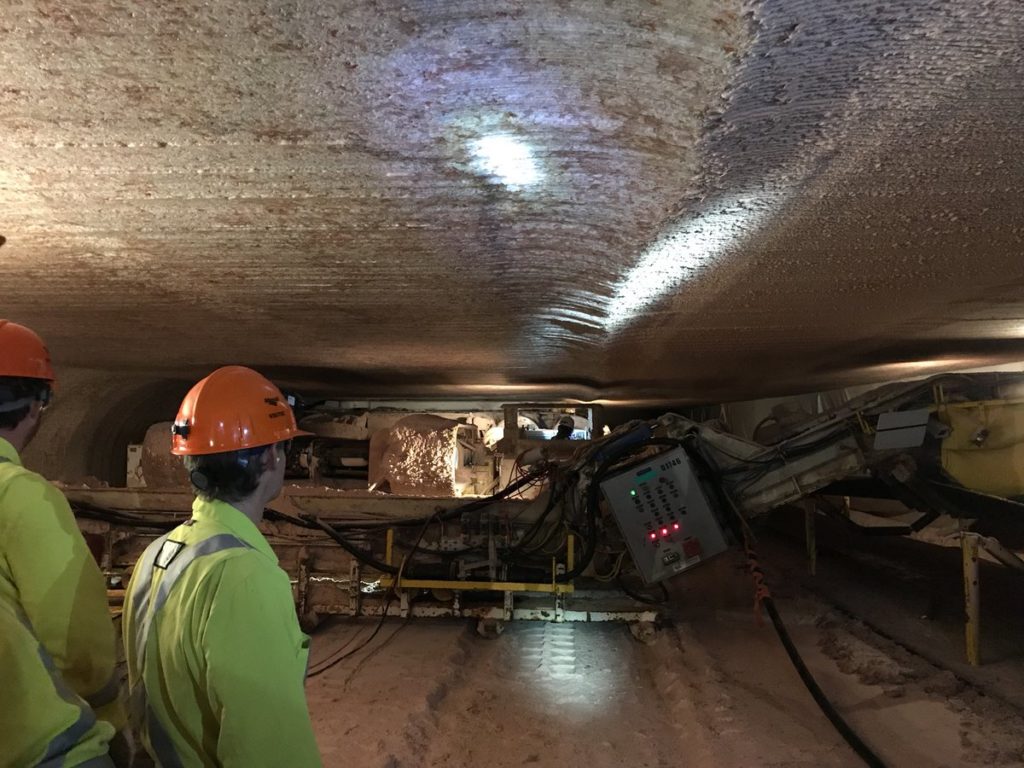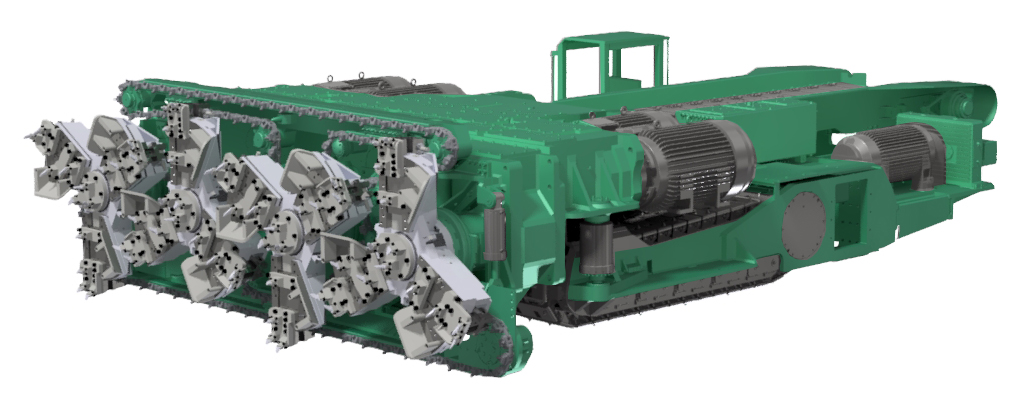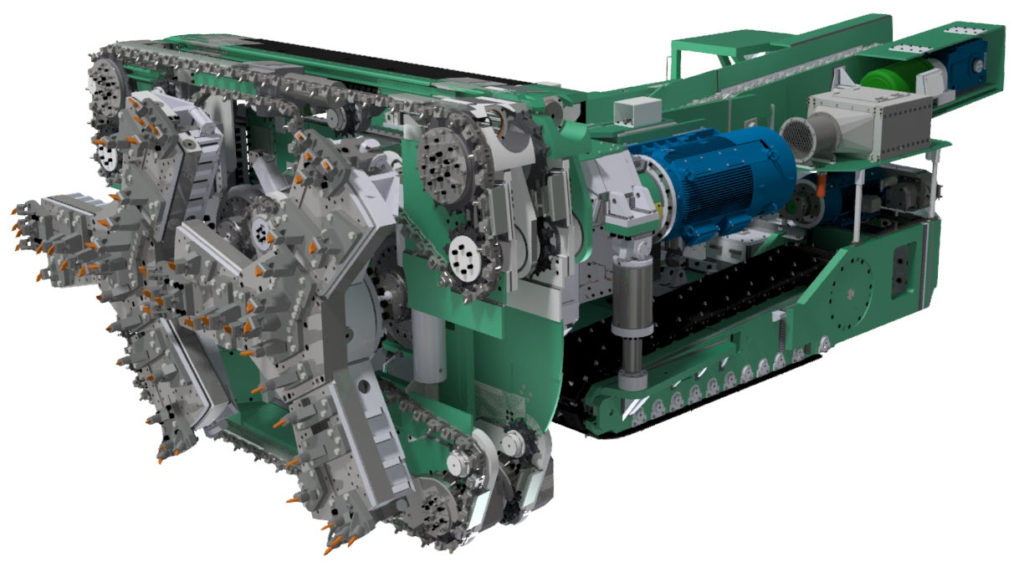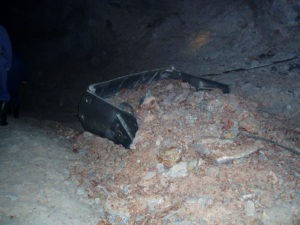
This is Part 2 of my story about working at a potash mine in Saskatchewan. If you haven’t read Part 1, here is the link to it “Potash Stories from 3000 Feet Down – Part 1“. It’s best to read it first.

Flooded Russian Potash Mine
As mentioned in Part 1, water seepage and potential leaks were always an operational concern. There were essentially two main fears; (i) that a borer would tunnel into an unforeseen collapse zone (i.e. an ancient sink hole) or (ii) that long term deformations in the mine would result in cracking of the overlying protective salt layer resulting in water inflow.
Any time wet spots were seen on the roof, the mining engineers or geologists were called out to take a look.
Sometimes the wet area was due to pockets of interstitial moisture. Other times it might have just been oil from a blown hydraulic hose on the borer. Wet spots all look the same when covered in dust.
Water ingress was such a concern in that an unmined pillar of 100 ft. would be left around all exploration core holes. These 3,000 ft. holes were supposedly plugged after drilling but you could never be certain of that. Furthermore, you couldn’t be certain of their location at potash depth. Hence, we didn’t want to mine anywhere close to them.
The process plant also had several water injection wells whereby excess water was injected into geological formations deep below the potash level. We left a 700 ft. pillar around these injection wells.
Carnallite is a magnesium salt that we encountered in some areas of the mine. It was weaker than the halite, resulting in more rapid room closure and deteriorating ground conditions. It was also hydroscopic and could absorb moisture out of the air. Sometimes we would water the underground travel ways to mitigate dust issues. With the resulting high humidity sometimes the carnallite areas might start to drip water. This resulted in another call to the engineers to come out and investigate.
Working on a production crew brings new learnings.
My period as a production foreman was great. When first assigned to this role, I was less than enthusiastic but when it was over 6 months later, I appreciated the opportunity. As a production foreman, we had a crew of 15 to 20 people responsible for mining 9,500 tons over a 12 hour shift. There was one foreman in the underground dispatch room and one face foreman travelling around supervising the borers and inspecting conveyors.
Ore grade control was a key responsibility of both the borer operator and mine foreman. The goal for the borer operator was to cut the roof even with the top of the high grade potash bed. The goal for the foreman was to ensure the operator was maintaining his goal. However, when looking at the potash face all the beds generally looked the same, especially when they are dusty.

Feel the glow
One key distinction was that the middle low grade bed had a higher percentage of insol clays. It was used as a marker bed. You would take your hardhat lamp and run it down against the wall. In the upper high grade potash bed, the cap lamp would have a halo, not unlike like the glowing salt rock lamps you see in stores. In the marker bed the halo would disappear, like putting a lamp against a rock wall.
Thus using the lamp you could identify the top of the marker bed, which was supposed to be kept 3.5 to 4 ft. off the floor. If borer operators were consistently more than 12 “ inches off optimal level, they could be written up (i.e. reprimanded). This was one of my tasks as foreman and I always hated doing it.
Lasers were used to guide the borer in a straight line but the marker bed was used for vertical control. Nowadays the use of machine mounted ore grade monitors is an option. By the way, if you’re looking at a potash project, be aware of the grade units being reported. A previous blog discusses this “Potash Ore Grades – Check the Units”.
The underground conveyor network consisted of 32” conveyors, feeding onto 42” conveyors, feeding on to 48”or 54” conveyors. Typically the length of the larger conveyors was in the range of a mile (5,000-6,000 ft.). The conveyors were all roof mounted, allowing for easy clean up underneath. Roof mounting was critical. Even some of the 600 hp conveyor drive stations were roof mounted, structure and all.
Conveyors were the reason for my one and only safety incident.

4-rotor borer side pass
First a little background. The underground ore storage capacity at K1 was about 3,000 tons. If the underground bins were filled anytime during a shift, the entire conveyor system would automatically trip off; all 10 miles of it. If you happened to have a mile long conveyor shut off while it was loaded to the brim with ore, good luck starting it up again.
If this happened, there were two choices. You could bring in the operators from the borers to start shovelling off the conveyor until it was unloaded enough to re-start. This option went over like a lead balloon with the crew.
The other not so great option was to use a scooptram to lift the belt counterweight up to reduce the belt tension. This allows the drive pulleys to start spinning. Then by lowering the counterweight back down perhaps the drives can inch the belt along. The idea being that possibly the momentum of the moving mass of potash would keep it moving. The downside is that you could break the belt. There was nothing worse than having to tell the cross shift they have both a stalled conveyor and a broken belt. Have a good shift people.
At 4 a.m. working as night shift face foreman, I knew the underground bins were nearing full. Driving along I saw that the mainline conveyor was full and spilling over the sides. A worst case conveyor shutdown was imminent. I called the dispatch office to ask why he hasn’t been shutting down borers and conveyors but there was no answer.
After several unanswered calls I started to hustle back to dispatch. I remember driving alongside the conveyor thinking “don’t shut off, don’t shut off”. Just then a heavy duty service vehicle pulled out of a cross-cut and I plowed right into it. I wasn’t going very fast (~20 km), but when a Toyota Land Cruiser hits a steel plate truck, the Toyota is the loser. The front end crumpled, and I later was told that there was major frame damage.
I’m not sure why the other driver didn’t see my lights. I’m also certain his lights were not on. Nevertheless, I did get written up for this incident with a reprimand for my personnel file. The reprimander had become the reprimandee. I still insist that the incident wasn’t my fault.
The Land Cruiser laid around the shaft for a few days until it could be hoisted up to surface. Everyone coming on shift got to see it . Once it was hoisted up, it laid outside the headframe for a few more days for all the surface workers to see. Ultimately, this incident resulted in the underground miners giving me the nickname “Crash”.
This is where I’ll end the potash story.
Conclusion
Saskatchewan potash is a unique mining situation. It has its own history and mining method. The people are great and it’s a great place to learn the difference between engineering school and real life.

Mine Engineering Dream Team
By the way, I also learned that small town Saskatchewan loves their senior hockey league (20-30 year age range). The local towns compete all winter; sometimes combatively. It was Esterhazy vs. Langenburg vs. Whitewood vs. Rocanville vs. Stockholm vs. Moosomin.
One of the first questions asked in my job interview at Mosaic was if I played hockey. You see, the ideal candidate for the job would have been an ex-NHL player, preferably an enforcer, who is also a mining engineer. Gotta stack the local team.
If you enjoy reading these types of stories about working as an engineer, there is an entire book on the subject, written by a former colleague of mine. You can learn a bit more about this civil engineer’s experiences working around the global at this link “Life as an Engineer – Read All About It”






 Potash is termed a plastic rock, in that it will deform slowly under stress. Hard rock will build up stresses and erupt violently in a “rock burst”. Potash will go with the flow and deform. Pillars will compress vertically and expand horizontally. Room heights can decrease over time as much as 6 inches over several weeks in higher stress areas.
Potash is termed a plastic rock, in that it will deform slowly under stress. Hard rock will build up stresses and erupt violently in a “rock burst”. Potash will go with the flow and deform. Pillars will compress vertically and expand horizontally. Room heights can decrease over time as much as 6 inches over several weeks in higher stress areas. For a year or so, I also worked as a production foreman. It was an interesting role. How does a young mining engineer four years out of school tell guys working underground for 20 years what they need to do?
For a year or so, I also worked as a production foreman. It was an interesting role. How does a young mining engineer four years out of school tell guys working underground for 20 years what they need to do?
